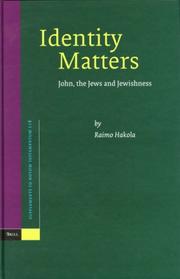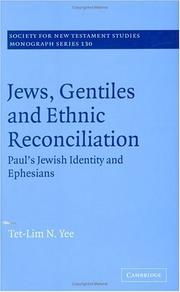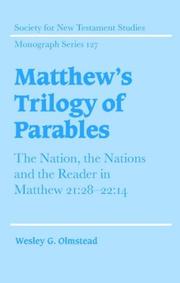| Listing 1 - 10 of 10 |
Sort by
|
Book
ISBN: 0300252188 9780300252187 Year: 2020 Publisher: New Haven ; London : Yale University Press,
Abstract | Keywords | Export | Availability | Bookmark
 Loading...
Loading...Choose an application
- Reference Manager
- EndNote
- RefWorks (Direct export to RefWorks)
A fresh look at Acts of the Apostles and its depiction of Jewish identity within the larger Roman era When considering Jewish identity in Acts of the Apostles, scholars have often emphasized Jewish and Christian religious difference, an emphasis that masks the intersections of civic, ethnic, and religious identifications in antiquity. Christopher Stroup’s innovative work explores the depiction of Jewish and Christian identity by analyzing ethnicity within a broader material and epigraphic context. Examining Acts through a new lens, he shows that the text presents Jews and Jewish identity in multiple, complex ways, in order to legitimate the Jewishness of Christians.
Jews in the New Testament. --- Church history --- Jews --- Identity --- Biblical teaching. --- Bible. --- Criticism, interpretation, etc. --- Römisches Reich

ISBN: 1280867833 9786610867837 9047407253 1433706385 9789047407256 9004143246 9781433706387 9789004143241 9781280867835 6610867836 Year: 2005 Volume: 118 Publisher: Leiden Boston Brill
Abstract | Keywords | Export | Availability | Bookmark
 Loading...
Loading...Choose an application
- Reference Manager
- EndNote
- RefWorks (Direct export to RefWorks)
This book challenges current scholarly consensus concerning John’s references to the Jews in two ways. First, the author suggests that John’s portrayal of the Jews cannot be understood as a response to the violent policy of John’s opponents. Second, the author claims that John’s portrayal of Jewishness is much more ambivalent than is often claimed today. The first part of the book offers a detailed criticism on the so called two-level reading strategy which claims that John’s references to the Jews emerge from the conflict with rabbinic Judaism. The second part examines in detail John’s relationship to some basic markers of Jewishness. The book contributes to the ongoing discussion of anti-Judaism in John and efforts to understand John’s historical setting.
Jews in the New Testament. --- Jews in the New Testament --- Christianity and other religions --- Judaism --- Christianity and antisemitism --- Christianity --- Religion --- Philosophy & Religion --- Relations --- Christianity and antisemitism. --- Judaism. --- Christianity. --- Bible. --- Criticism, interpretation, etc. --- Antisemitism and Christianity --- Jean (Book of the New Testament) --- Johanisi (Book of the New Testament) --- Johannesevangelium --- John (Book of the New Testament) --- Yohan pogŭm --- Yohane den (Book of the New Testament) --- Yūḥannā (Book of the New Testament) --- Brotherhood Week --- Juifs dans le Nouveau Testament --- Christianisme --- Judaïsme --- Christianisme et antisémitisme --- Bible. John --- Criticism, interpretation, etc --- Ioganaĭ (Book of the New Testament) --- Иоганай (Book of the New Testament) --- Christianity and other religions - Judaism. --- Judaism - Relations - Christianity.
Book
ISBN: 9789004158382 9004158383 9786611921675 128192167X 9047421558 9789047421559 Year: 2007 Volume: 71 Publisher: Leiden Boston Brill
Abstract | Keywords | Export | Availability | Bookmark
 Loading...
Loading...Choose an application
- Reference Manager
- EndNote
- RefWorks (Direct export to RefWorks)
The articles discuss various aspects of Jewish identity in the Greco-Roman period. Was there a common ‘Jewish’ identity, and how could it be defined? How could different groups develop and maintain their identity within the challenge of Hellenistic and early Roman culture? What about the images of ‘others’? How could some of those ‘others’ adopt a Jewish lifestyle or identity, whereas others, abandoned their inherited identity? Among the questions discussed are the translation of Ioudaios, Jewish and universal identity in Philo, the status of women and their conversion to Judaism, the participation of non-Jews in the temple cult, the practice of Emperor worship in Judaea, and the image of Egypt and the Nile as ‘others’ in Philo. Two articles enter the debate whether Jewish identity had an ongoing influence within early Christianity, in Paul and in the rules known as the Apostolic Decree.
Jews --- Jews in the New Testament. --- Judaism --- Judaism (Christian theology) --- Juifs --- Juifs dans le Nouveau Testament --- Judaïsme --- Judaïsme (Théologie chrétienne) --- Identity. --- History --- History of doctrines --- Identité --- Histoire --- Histoire des doctrines --- 933.51 --- Identity, Jewish --- Jewish identity --- Jewishness --- Jewish nationalism --- Geschiedenis van het Joodse volk: Romeinse tijd II--(70-325) --- Jews -- History -- 168 B.C.-135 A.D. --- Jews -- Identity. --- Judaism -- History -- Talmudic period, 10-425. --- Judaism (Christian theology) -- History of doctrines -- Early church, ca. 30-600. --- Jews in the New Testament --- 933.51 Geschiedenis van het Joodse volk: Romeinse tijd II--(70-325) --- Jewish law --- Identity --- Ethnic identity --- Race identity --- Legal status, laws, etc.
Book
ISBN: 1280925353 9786610925353 0889205515 9780889205512 Year: 2006 Publisher: Waterloo Wilfrid Laurier University Press
Abstract | Keywords | Export | Availability | Bookmark
 Loading...
Loading...Choose an application
- Reference Manager
- EndNote
- RefWorks (Direct export to RefWorks)
Can archaeological remains be made to ""speak"" when brought into conjunction with texts? Can written remains, on stone or papyrus, shed light on the parables of Jesus, or on the Jewish view of afterlife? What are the limits to the use of artifactual data, and when is the value overstated? Text and Artifact addresses the complex and intriguing issue of how primary religious texts from the ancient Mediterranean world are illuminated by, and in turn illuminate, the ever-increasing amount of artifactual evidence available from the surrounding world. The book honours Peter Rich
Church history --- Judaism --- Jews in the New Testament. --- History --- Bible. --- History of contemporary events. --- History of Biblical events. --- Criticism, interpretation, etc. --- Biblia. N.T. --- Historia --- Sucesos contemporáneos. --- Sucesos biblicos. --- Cristianismo --- ca. 30-600, iglesia primitiva. --- Crítica, interpretación, etc

ISBN: 0521838312 0521091462 1107139937 0511171595 0511109784 0511298692 0511488211 1280422025 0511197357 0511109474 9780521838313 9780511109782 9780511109478 9780511488214 9780521091466 9781107139930 9781280422027 9780511171598 9780511197352 9780511298691 Year: 2005 Volume: 130 Publisher: Cambridge New York Cambridge University Press
Abstract | Keywords | Export | Availability | Bookmark
 Loading...
Loading...Choose an application
- Reference Manager
- EndNote
- RefWorks (Direct export to RefWorks)
Much scholarship has focused on Paul's insistence on Gentile membership of the people of God equally with Jews. Dr Yee's study of Ephesians 2 reveals how the distinctively Jewish world view of the author of Ephesians underlies this key text. He explores how the Ephesians' author provides a resolution to one of the thorniest issues regarding two ethnic groups in the earliest period of Christianity: can Jew and Gentile, the two estranged human groups, be one (people of God) and if so, how? Setting Ephesians 2 as fully as possible into its historical context, he describes some of the relevant Jewish features and demonstrates them, revealing many explosive but hidden issues. This book provides an important contribution to the continuing reassessment of Christian and Jewish self-understanding in regard to each other during the critical period of the latter decades of the first century CE.
Gentiles in the New Testament --- Gentils dans le Nouveau Testament --- Heidenen in het Nieuwe Testament --- Jews in the New Testament --- Joden in het Nieuwe Testament --- Juifs dans le Nouveau Testament --- Jews in the New Testament. --- Gentiles in the New Testament. --- 227.1*4 --- Brief van Paulus aan de Efesiërs --- 225*1 --- 225.09 --- Leven van Jezus Christus in het Nieuwe Testament. Historische Jezus Christus --- Parafrasen op het Nieuwe Testament. Bewerkingen van het Nieuwe Testament --- 227.1*4 Brief van Paulus aan de Efesiërs --- 225.09 Parafrasen op het Nieuwe Testament. Bewerkingen van het Nieuwe Testament --- 225*1 Leven van Jezus Christus in het Nieuwe Testament. Historische Jezus Christus --- Bible. --- Criticism, interpretation, etc. --- Bible. N.T. Ephesians II --- Criticism, interpretation, etc --- Arts and Humanities --- Religion
Book
ISBN: 1283576783 9786613889232 0199927065 0199927049 9780199927043 9780199927067 9781283576789 9780195297706 0195297709 6613889237 Year: 2011 Publisher: Oxford : Oxford University Press,
Abstract | Keywords | Export | Availability | Bookmark
 Loading...
Loading...Choose an application
- Reference Manager
- EndNote
- RefWorks (Direct export to RefWorks)
Although major New Testament figures--Jesus and Paul, Peter and James, Jesus' mother Mary and Mary Magdalene--were Jews, living in a culture steeped in Jewish history, beliefs, and practices, there has never been an edition of the New Testament that addresses its Jewish background and the culture from which it grew--until now. In The Jewish Annotated New Testament, eminent experts under the general editorship of Amy-Jill Levine and Marc Z. Brettler put these writings back into the context of their original authors and audiences. And they explain how these writings have affected the relations o
Judaism. --- Jews in the New Testament. --- Christianity and other religions --- Judaism --- Jews --- Religions --- Semites --- Brotherhood Week --- Relations --- Christianity. --- Religion --- Bible. --- Ba-yon Tipan --- Bagong Tipan --- Jaji ma Hungi --- Kainē Diathēkē --- New Testament --- Nouveau Testament --- Novo Testamento --- Novum Testamentum --- Novyĭ Zavet --- Novyĭ Zavi︠e︡t Gospoda nashego Īisusa Khrista --- Novyĭ Zavit --- Nuevo Testamento --- Nuovo Testamento --- Nye Testamente --- Perjanjian Baru --- Dhamma sacʻ kyamʻʺ --- Injīl --- Criticism, interpretation, etc. --- Criticism, interpretation, etc., Jewish.
Book
ISBN: 9781498217521 1498217524 9781498217514 1498217516 9781498217538 1498217532 Publisher: Wipf and Stock Publishers.
Abstract | Keywords | Export | Availability | Bookmark
 Loading...
Loading...Choose an application
- Reference Manager
- EndNote
- RefWorks (Direct export to RefWorks)
The Letter to the Romans explains the way Paul thought Jewish covenantal identity continued now that the messianic era had begun. More particularly, Paul addresses the relevance of Abraham for Jews and gentiles, the role of Torah, and the way it is contextualized in Christ. All too often, however, these topics are read in supersessionist ways. This book argues that such readings are unpersuasive. It offers instead a post-supersessionist perspective in which Jewish covenantal identity continues in Paul's gospel. Paul is no destroyer of worlds. The aim of this book is to offer a different view of the key interpretive points that lead to supersessionist understandings of Paul's most important letter. It draws on the findings of those aligned with the Paul within Judaism paradigm and accents those findings with a light touch from social identity theory. When combined, these resources help the reader to hear Romans afresh, in a way that allows both Jewish and non-Jewish existing identities continued relevance.
Jews in the New Testament. --- Gentiles in the New Testament. --- Jews --- Chosen people (Jews) --- Election of Israel --- Israel, Election of --- Election (Theology) --- Judaism --- People of God --- Election, Doctrine of. --- Chosen people --- Doctrine of election --- Mission --- Relations --- Bible. --- Epître aux Romains (Book of the New Testament) --- List do Rzymian (Book of the New Testament) --- Roma-sŏ --- Római levél --- Romans (Book of the New Testament) --- Romasŏ --- Criticism, interpretation, etc.
Book
ISBN: 1498242324 9781498242325 1532617569 9781532617560 9781498242332 1498242332 Year: 2018 Publisher: Eugene, Oregon
Abstract | Keywords | Export | Availability | Bookmark
 Loading...
Loading...Choose an application
- Reference Manager
- EndNote
- RefWorks (Direct export to RefWorks)
Judaism (Christian theology) --- Christianity and other religions --- Biblical teaching. --- Judaism --- Paul, --- Pavel, --- Pavol, --- Paulus, --- Paulos, --- Pōghos, --- Paweł, --- Pawełm --- Būlus, --- Pablo, --- Paulo, --- Paolo, --- Pál, --- Apostolos Paulos --- Saul, --- القديس بولس الرسول --- بولس، --- 사도바울 --- Relations with Jews. --- Bible. --- Epître aux Romains (Book of the New Testament) --- List do Rzymian (Book of the New Testament) --- Roma-sŏ --- Római levél --- Romans (Book of the New Testament) --- Romasŏ --- Criticism, interpretation, etc. --- Jews in the New Testament --- Gentiles in the New Testament --- Relations&delete& --- Christianity --- Jews --- Religions --- Semites --- Religion --- 227.1*1 --- 227.1*1 Brief van Paulus aan de Romeinen --- Brief van Paulus aan de Romeinen --- Relations --- Brotherhood Week

ISBN: 0521831547 0521036305 1107139147 0511180470 0511063040 0511307381 0511488122 1280421800 0511204558 0511071507 9780521831543 9780511063046 9780511488122 9780521036306 Year: 2003 Volume: 127 Publisher: Cambridge Cambridge University Press
Abstract | Keywords | Export | Availability | Bookmark
 Loading...
Loading...Choose an application
- Reference Manager
- EndNote
- RefWorks (Direct export to RefWorks)
Wesley Olmstead examines the parables of the Two Sons, the Tenants and the Wedding Feast against the backdrop of the wider Matthean narrative. He explores Matthew's characterization of the Jewish leaders, the people and the nations, and assesses the respective roles of Israel and the nations in the plot of Matthew's Gospel. Against the current of contemporary Matthean scholarship, Olmstead argues both that the judgement this trilogy announces falls upon Israel (and not only her leaders) and that these parables point to the future inclusion of the nations in the nation that God had promised to raise up from Abraham. Bringing both literary-critical and redaction-critical tools to bear on the texts at hand, Olmstead not only elucidates the intended meanings of this parabolic trilogy but also attempts to determine the responses they elicited from their first readers. Transcending Matthean scholarship, this book has implications for all Gospel studies.
Two sons (Parable) --- Wicked husbandmen (Parable) --- Great supper (Parable) --- Jews in the New Testament --- Bible --- Criticism, interpretation, etc --- Bruiloftsmaal (Parabel) --- Feast [Parable of ] --- Festin des noces (Parabole) --- Gentiles in the New Testament --- Gentils dans le Nouveau Testament --- Great Feast (Parable) --- Guest who made excuses (Parable) --- Heidenen in het Nieuwe Testament --- Invités discourtois [Parabole des ] --- Joden in het Nieuwe Testament --- Juifs dans le Nouveau Testament --- King's son [Marriage of ] (Parable) --- Marriage of the king's son (Parable) --- Noces [Festin des ] (Parabole) --- Onwillige genodigden (Parabel) --- Supper [Parable of ] --- Unwilling guests (Parable) --- Wedding feast (Parable) --- Wedding garment (Parable) --- Bible NT. Gospels. Matthew --- 225*33 --- 226.2 --- 225*33 Parabels. Gelijkenissen --- Parabels. Gelijkenissen --- Husbandmen, Wicked (Parable) --- Wicked tenants (Parable) --- Wicked vinedressers (Parable) --- Feast, Parable of --- Great feast (Parable) --- Guests who made excuses (Parable) --- King's son, Marriage of (Parable) --- Supper, Parable of --- Evangelie volgens Matteüs --- Bible. --- Criticism, interpretation, etc. --- Bible. N.T. Matthew XXI,28-XXII,14 --- Arts and Humanities --- Religion --- Gentiles in the New Testament. --- Jews in the New Testament.
Book
ISBN: 1630874752 9781630874759 9781625648242 1625648243 Year: 2014 Publisher: Eugene, Oregon
Abstract | Keywords | Export | Availability | Bookmark
 Loading...
Loading...Choose an application
- Reference Manager
- EndNote
- RefWorks (Direct export to RefWorks)
Paul, --- Pavel, --- Pavol, --- Paulus, --- Paulos, --- Pōghos, --- Paweł, --- Pawełm --- Būlus, --- Pablo, --- Paulo, --- Paolo, --- Pál, --- Apostolos Paulos --- Saul, --- القديس بولس الرسول --- بولس، --- 사도바울 --- Jews in the New Testament --- Gentiles in the New Testament --- 227.1*3 --- 227.1*1 --- 227.1*1 Brief van Paulus aan de Romeinen --- Brief van Paulus aan de Romeinen --- 227.1*3 Brief van Paulus aan de Galaten --- Brief van Paulus aan de Galaten --- Bible. --- Epître aux Romains (Book of the New Testament) --- List do Rzymian (Book of the New Testament) --- Roma-sŏ --- Római levél --- Romans (Book of the New Testament) --- Romasŏ --- Brief aan die Galasiërs --- Epistle to the Galatians (Book of the New Testament) --- Galasiërs --- Galatians (Book of the New Testament) --- Galladia --- Galladia-sŏ --- Galladiasŏ --- Garateya sho --- Kalladiasŏ --- Criticism, interpretation, etc.
| Listing 1 - 10 of 10 |
Sort by
|

 Search
Search Feedback
Feedback About UniCat
About UniCat  Help
Help News
News